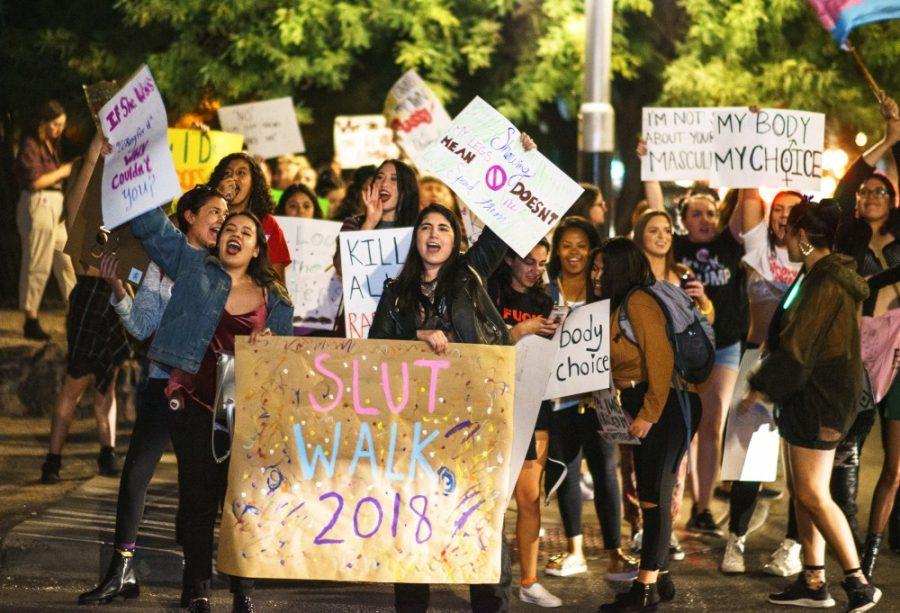SlutWalk aims to reclaim and redefine what being a “slut” means and put an end to victim blaming in cases of sexual assault in the Southwest. Reclaiming that term in honor of transgender women and women of color is of major importance.
The 2019 SlutWalk, which will begin on Nov. 13 at the University of Arizona Women’s Plaza of Honor, expressed this purpose with the slogan: “The radical notion that no one deserves to be raped.”
The annual SlutWalk aims to raise awareness of how victims of sexual assault see themselves and how others commonly see them from different points of view, according to UA gender and women’s studies professor Patricia MacCorquodale.
“SlutWalks protest the blaming of the victim that occurs when sexual assault survivors are criticized for their clothing and sexual history,” MacCorquodale said in an email.
RELATED: The SlutWalk returns to campus
The UA feminist group Feminists Organized to Resist, Create, and Empower (FORCE) has organized the annual SlutWalk to be as inclusive as possible.
FORCE co-directors and SlutWalk co-organizers Vane Gomez and Kelsey Valdez made inclusivity one of the main goals of the UA SlutWalk
“It’s been a very intentional space to be inclusive,” Gomez said. “I hope it becomes a place for all of those people who have been put on the margins.”
For Gomez, who identified herself as a marginalized person, personal reclamation of the word “slut” was powerful.
“You don’t get to decide what this word means for me, because you already tried to decide how I navigate this world as a queer brown woman,” Gomez said. “If I’m going to be a slut, I’m going to be a slut. If that means I’m going to sleep tonight, that’s what it means. If tomorrow it means I’m going to go party and have the time of my life, then that’s what it means to me.”
The SlutWalk itself has been marginalized by some critics, according to Monica Casper of the UA Department of Gender & Women’s Studies.
“[A common misperception is] that it is somehow not serious; that it is an opportunity for girls and women to dress and behave as ‘sluts,’ for example, showing up in public in clothes they wouldn’t ordinarily wear,” Casper explained in an email. “Critics often do not look past the name or the action to the deeper critique of rape culture.”
According to Casper, rape culture and sexual assault have not gone away. Rates of sexual violence against transgender women, people of color, indigenous women and other minority groups have been increasing or not changing.
“I’ve been doing this kind of work for decades, and we have not managed to move the bar statistically on violence against girls and women. Indeed, in many spaces and against some populations, such as trans women of color, it is increasing,” Casper said.
RELATED: Miss Native American University of Arizona pageant continues to share tradition and culture
According to a 2017 study conducted through the University of Pittsburgh Graduate School of Public Health, race and ethnicity were “significantly associated with past-year sexual assault,” especially among transgender women. According to the study, 55.6% of black transgender students suffered sexual assault — the highest rate of sexual assault among those surveyed — as opposed to the 8% of non-transgender (cisgender) white women.
The SlutWalk challenges established beliefs everywhere, Casper said, but it has a different connotation in Arizona as opposed to other states.
“Underfunded public schools, lack of sexual and reproductive health education, and we’re consistently ranked near the bottom 20% of best and worst states for women. We also suffer from a lack of access to appropriate sexual and reproductive health care,” Casper said. “SlutWalk in a state such as ours is a significant challenge to the status quo.”
In addition to those troubling statistics, Gomez pointed out that indigenous women suffer greater risks in Arizona than in other states.
“Arizona is top ten [highest rates] for missing and murdered Indigenous women,” Gomez said. “I think this movement in particular is significant to raising awareness [and] creating a celebratory and healing space.”
RELATED: Women’s Hackathon promoting community through computers
The Urban Indian Health Institute supports Gomez’s claims. Not only is murder the third-highest cause of death among Native American women, but the Institute’s 2019 report on Missing and Murdered Indigenous Women and Girls found that the southwest U.S. consistently had the most cases of MMIWG. Tucson had the fourth-highest rate of MMIWG among U.S. cities and Arizona had the third-highest rate of MMIWG among U.S. states.
Women and gender resources graduate assistant Ndekela Sakala said the youth-driven aspect of the SlutWalk may be what it takes to change these statistics.
“I think it’s really important that youth are able to take charge in this, because ultimately the thing we’re trying to do — even for me, as a person who is 24 — is to make sure the world is livable for the next generation,” Salaka said. “The only way to do that is to listen to the next generation.”
To Valdez, the SlutWalk was a necessary outlet for everyone.
“I think we needed an outlet to express what is happening to us,” Valdez said, “in which every walk of life, every person can feel safe and comfortable sharing their story, and connected to one another.”
Follow Ella McCarville on Twitter















